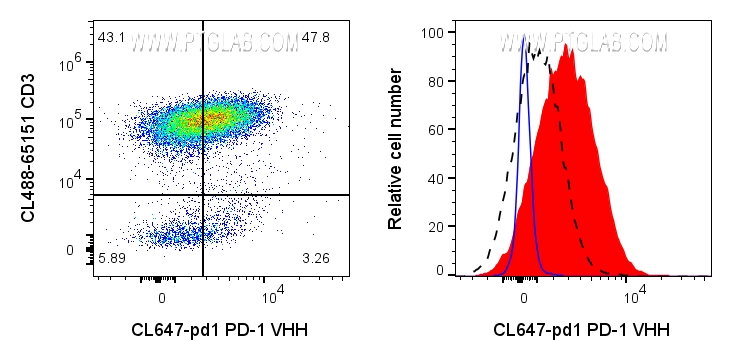ChromoTek CoraLite® Plus 647-conjugated PD-1 VHH
CL647-pd1 targets PD-1 in FC applications and shows reactivity with Human samples.
Host/Type
Alpaca VHH
Reactivity
Human
Applications
FC
Conjugate
CoraLite® Plus 647 Fluorescent Dye
Cat No : CL647-pd1
Synonyms
Validation Data Gallery
Product Information
CL647-pd1 targets PD-1 in FC applications and shows reactivity with Human samples.
| Applications | FC |
| Reactivity | Human |
| Conjugate | CoraLite® Plus 647 Fluorescent Dye |
| Type | Nanobody |
| Class | Recombinant |
| Host | Alpaca |
| Affinity | Picomolar range, below the assay limit (biolayer interferometry) |
| Molecular Weight | 13.874 kDa |
| Form | Liquid |
| Excitation/Emission Maxima Wavelengths | 654 nm / 674 nm |
| RRID | AB_3101931 |
| Storage Buffer | 500 mM NaCl, 10 mM HEPES pH 7.0, 5 mM EDTA, 0.09% sodium azide |
| Storage Condition | Store at -20°C |
| Background | Programmed cell death 1 (PD-1, also known as CD279) is an immunoinhibitory receptor that belongs to the CD28/CTLA-4 subfamily of the Ig superfamily. It is a 288 amino acid (aa) type I transmembrane protein composed of one Ig superfamily domain, a stalk, a transmembrane domain, and an intracellular domain containing an immunoreceptor tyrosine-based inhibitory motif (ITIM) as well as an immunoreceptor tyrosine-based switch motif (ITSM) (PMID: 18173375). PD-1 is expressed during thymic development and is induced in a variety of hematopoietic cells in the periphery by antigen receptor signaling and cytokines (PMID: 20636820). Engagement of PD-1 by its ligands PD-L1 or PD-L2 transduces a signal that inhibits T-cell proliferation, cytokine production, and cytolytic function (PMID: 19426218). It is critical for the regulation of T cell function during immunity and tolerance. Blockade of PD-1 can overcome immune resistance and also has been shown to have antitumor activity (PMID: 22658127; 23169436). It has been reported that PD-1 is heavily glycosylated and migrates with an apparent molecular mass of 47-55 kDa on SDS-PAGE, which is larger than its predicted mass of 32 kDa (PMID: 8671665; 17640856; 17003438). |
Documentation
| SDS |
|---|
| SDS_Immuno-Oncology VHHs (grouped) |

